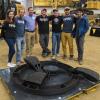Related Content
 |
Is Everything Code? As modern software processes become automated, one might argue that nearly everything in software development is code. Obviously, our software applications are comprised of code, but that’s only the start of it. Our tests, delivery orchestration, and someday even our software production could be automated. |
|
 |
Crowdsourced Testing: Give the People What They Want Crowdsourced testing is a great way to connect with users and ensure that the product idea, design, implementation, and nonfunctional elements meet their expectations—or, hopefully, even exceed them. But like any other test effort, crowdsourced testing is both a science and an art. Here's how to do it effectively. |
|
 |
Empathy-Driven Development: A Slack Takeover with Andrea Goulet Thought leaders from the software community are taking over the TechWell Hub to answer questions and engage in conversations. Andrea Goulet, the CEO of Corgibytes, hosted this Slack takeover and discussed how to help teams that want to be agile but aren't, and the importance of empathy in developing software. |
|
 |
Down-to-Earth Benefits from NASA's 3D-Printed Habitat Challenge To advance the technology needed to create sustainable housing solutions for trips to the moon, Mars, and beyond, as well as here on Earth, NASA is conducting the 3D-Printed Habitat Challenge. Teams compete to construct dwellings out of local, indigenous, or recyclable materials, and designs are out of this world. |
|
 |
Getting Faster Pull Requests in an Agile Environment Pull requests may not seem to fit into agile development, but they can work well if done right. If you can maintain feedback on your working software from frequent integration, using PRs can help people understand your code. The speed at which PRs can be reviewed depends on three things: context, size, and atomicity. |
|
 |
Leverage Your Actions to Get More Out of Test Automation Test design can contribute greatly to how manageable and maintainable your automation is. Hiding detailed steps in actions makes their automation easier to maintain, and the high-level actions can be leveraged to define less common tests. Here's how you can write tests as a sequence of actions to improve coverage. |
|
 |
Choosing the Right Tools for the Job The saying “If all you have is a hammer, everything looks like a nail” summarizes a cognitive bias we have to use tools that are most familiar to us, even if they are the wrong tools for the job. Software professionals often fall into this trap. Here are some tips on how to choose the right tools for your projects. |
|
 |
Visual Regression Testing: A Critical Part of a Mobile Testing Strategy Despite our best efforts to replicate customers' behavior in our test automation suites, teams often forget about nonfunctional requirements. An important one is visual perception—how users see and feel each application they use. Visual regression testing can fill a significant gap in user experience expectations. |







